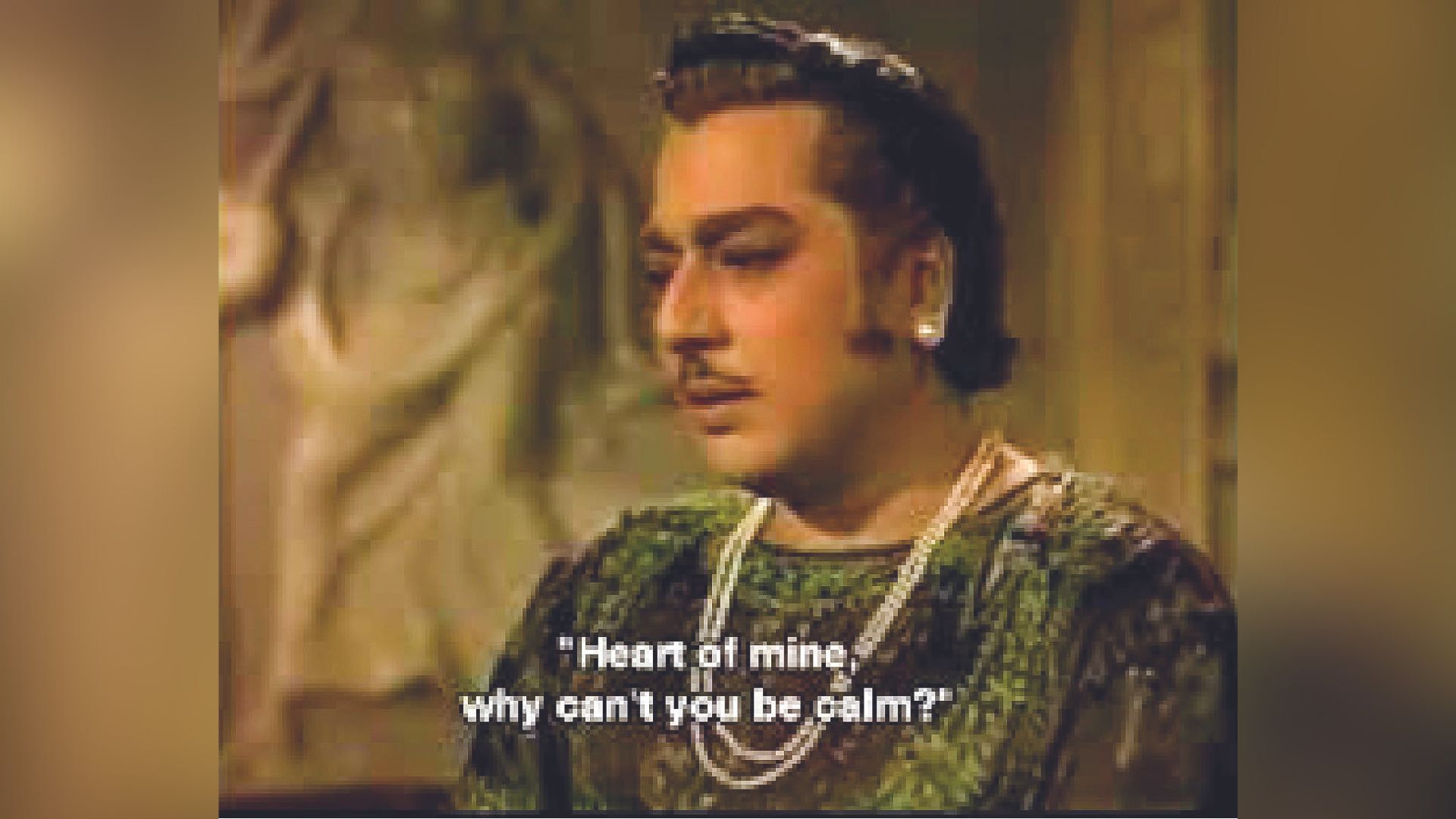Poets are Prophets ! They read the pulse of the society the best. Most ; also have this quality to maintain the beauty without being didactic and sermonising . Therefore their words are recited and memorised till date. Poets, world wide are also inadvertent translators of philosophy and social theories for the common man . Complex concepts hidden in thick religious , mythological and philosophical texts are condensed and simplified in a ‘Doha’ or a ‘couplet’ or a ‘sonnet’ essentially from their reading of the ‘ground’. The concept of Power , glory . beauty has been much written in verse . The futility and impermanence of it all is discussed below.
In the year 2006 marking the 75 years of Hindi Talkie Cinema ( Alam Ara was released in 1931) the ‘Outlook’ magazine conducted a poll among the music critics and experts to list the top twenty Hindi cinema songs. In that list Sahir Ludhiyanvi written, Roshan composed and Rafi rendered; “ mun re tu kahe ne dhir dhare vo nirmohi moh na jaane jinka moh kare….” From the 1964 film ‘Chitralekha’ directed by Kedar Sharma was on the top of the list. Well; these lists keep coming out periodically and one must not lament the non inclusion of many great songs, but this particular song is to be accorded respect for its sweet and sombre mood and the philosophy which it propounds.
The story of the film is about a King played by Pradeep Kumar a dancing girl , Meena Kumari and the spiritual Guru played by Ashok Kumar. Pradeep Kumar falls in love with the dancing girl and there is this conflict in his mind between duty and love. Ashok Kumar is the ideal person seemingly free of attachments and propagates shunning of material attachments, but he too is swayed by the charm of the dancing girl, who becomes his disciple. The film’s subtext is about leading a normal life and suggesting that spiritualism is the highest stage of materialism ; conveying that it is useless to abandon material comforts prematurely because your desires are not satisfied.
The song opens with :
“Mun re tu kahe na dhir dhare
Vo nirmohi moh ne jaane jinka moh kare “
In the song the King ( Pradeep Kumar ) is talking to himself consoling his wandering and restless mind ( mun ) that it should not lose patience as the other person ( the lady ) is free from any attachments ( moh)
The first stanza moves the idea ahead :
“ Is jeevan ki chadti dhalti dhoop ko kisne bandha
Rang pe kisne pehre dale
Roop ko kisne bandha
Kahe ye jatan kare
Man re tu …..”
Now he talks about the flux of time, stating that no one can control the movement of sun ,in the sunrise and sunset life moves , nothing is permanent implying that his sorrows too shall pass and so would the time tell on the age of the beauty. The colour of the skin along with the beauty shall fade as they cannot be caged and held captive ( roop ko kisne bandha). Therefore we should not try hard ( jatan ) to resist change as impermanence is inevitable. The implication is that we should contain our pride and vanity as time tests all.
The second and the last stanza sums up the thought :
“ Utna hi upkar samazh koi , jitna saath nibha de
Janam maran ka mael hai sapna
Ye sapna bisra de
Koi na sang mare
Mun re tu kahe na dhir…..”
Here he further tells his mind ( mun ) that whatever time one has spent with one’s partner should be considered as favour( upkar ) and this utopian thought of staying together life long ( janam maran ka mael ai sapna ) is a dream which should be abandoned . One should count one’s blessings !
It is a deeply philosophical song of Sahir who as a poet was quite adept at it. The core thought is that there is no use being attached to anything as it is impermanent . As long as there is association make the best of it and consider that as blessing . At the same time this beauty of which the beauteous are so proud shall wither with time , therefore what for such vanity? why such attachments? The song rings a familiar bell and one is reminded of the romantic poet John Keats’ lines from ‘An Ode to a Nightingale’:
“where beauty cannot keep her lustrous eyes Or new love pine at them beyond tomorrow”
( where beauty and glow of the eyes fades away and so does love!)
Ibrahim Zauq the famous Urdu poet in the Court of Bahadur Shah Zafar states in his Gazal ‘Lai hayat Aayee Qazaa..’ the same idea so well . He was writing in mid 19th century about a 100 year prior to Sahir. Was Sahir inspired by him in the above song? :
“ behtar to hai yahi ki na duniya se dil lage
Par kya karen jo kaam na be- dil – lagi chale”
( it is better that there be no attachment in life ; But what else to do because it is not possible to exist , to work , to perform without attachment or devotion!).
The poet captures the ‘dualism’ the ‘conflict’ perfectly!
In another ‘sher’ ( couplet) of the same Gazal he states:
“ duniya ne kis ka rah-e- fana men diya hai saath
Tum bhi chale chalo yunhi jab tak chali chale” (In the path of death one has to move alone; the world is never with you;
Therefore keep moving till such time you exist! ).
The lines of Sahir above “ utna hi upkaar samaz koi jitna saath nibha de.. Janam maran ka mel hai sapna….” Do sound similar!
P. B. Shelly another great romantic poet , talks of the impermanence of Glory and fame in his famous sonnet ;
‘Ozymandias of Egypt’
I met a traveller from an antique land
Who said : Two vast and trunkless legs of stone
Stand in the desert. Near them on the sand
Half sunk , a shatter’d visage lies whose frown
And wrinkled lip and sneer of cold command
Tell that its sculptor well those passions read
Which yet survive stamp’d on these lifeless things,
The hand that mock’d them and the heart that fed;
And on the pedestal these words appear :
‘My name is Ozymandias , king of kings:
Look at my works , ye mighty , and despair !
Nothing beside remains. Round the decay
Of that colossal wreck, boundless and bare ,
The lone and level sands stretch far away.
The poet states that a traveller told him that in a desert a vast statue was seen whose only two legs were on the ground and the body and the face were lying on the ground. The expressions of cruelty , arrogance (wrinkled lips) and power were well portrayed by the artist . The irony was reflected in the writing on the stand ( pedestal ) which stated the name of the King asking the passer by to look at his “works ye mighty and despair “which with time was now in decay and abandon in the desert . The words sounded so hollow . Emptiness laughs at the Mighty King ; emptiness of fame, of Material splendour , of People – the most important ingredient of ‘Leadership’.
The above sonnet ends with a cold ‘gong’! Leaving the reader ‘stumped’ and conveys succinctly the impermanence of ‘fame and glory’ . Some words and sentences remain with us for long:
“Two vast and trunkless legs of stone Stand in the desert”,
“Nothing beside remains”,
“The lone and level sands stretch far away”.
[“Sab Thaath pada reh jayega, jab laad chalega Banjara”
— Nazir Akbarabadi ]























